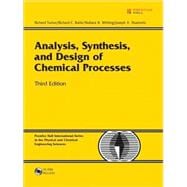
| Material on the CD-ROM | p. xix |
| Preface | p. xxiii |
| About the Authors | p. xxvii |
| List of Nomenclature | p. xxix |
| Conceptualization and Analysis of Chemical Processes | p. 1 |
| Diagrams for Understanding Chemical Processes | p. 5 |
| Block Flow Diagrams (BFDs) | p. 7 |
| Process Flow Diagram (PFD) | p. 9 |
| Piping and Instrumentation Diagram (P&ID) | p. 26 |
| Additional Diagrams | p. 32 |
| Three-Dimensional Representation of a Process | p. 33 |
| The 3-D Plant Model | p. 42 |
| Summary | p. 44 |
| References | p. 45 |
| Short Answer Questions | p. 45 |
| Problems | p. 46 |
| The Structure and Synthesis of Process Flow Diagrams | p. 51 |
| Hierarchy of Process Design | p. 51 |
| Step 1-Batch versus Continuous Process | p. 52 |
| Step 2-The Input/Output Structure of the Process | p. 57 |
| Step 3-The Recycle Structure of the Process | p. 68 |
| Step 4-General Structure of the Separation System | p. 84 |
| Step 5-Heat-Exchanger Network or Process Energy Recovery System | p. 84 |
| Information Required and Sources | p. 84 |
| Summary | p. 84 |
| References | p. 86 |
| Short Answer Questions | p. 88 |
| Problems | p. 88 |
| Batch Processing | p. 93 |
| Design Calculations for Batch Processes | p. 93 |
| Gantt Charts and Scheduling | p. 100 |
| Nonoverlapping, Overlapping Operations, and Cycle Times | p. 101 |
| Flowshop and Jobshop Plants | p. 104 |
| Product and Intermediate Storage and Parallel Process Units | p. 110 |
| Design of Equipment for Multiproduct Batch Processes | p. 116 |
| Summary | p. 119 |
| References | p. 119 |
| Short Answer Questions | p. 119 |
| Problems | p. 120 |
| Chemical Product Design | p. 123 |
| Strategies for Chemical Product Design | p. 124 |
| Needs | p. 126 |
| Ideas | p. 128 |
| Selection | p. 129 |
| Manufacture | p. 131 |
| Batch Processing | p. 132 |
| Economic Considerations | p. 132 |
| Summary | p. 133 |
| References | p. 133 |
| Tracing Chemicals through the Process Flow Diagram | p. 135 |
| Guidelines and Tactics for Tracing Chemicals | p. 135 |
| Tracing Primary Paths Taken by Chemicals in a Chemical Process | p. 136 |
| Recycle and Bypass Streams | p. 142 |
| Tracing Nonreacting Chemicals | p. 146 |
| Limitations | p. 147 |
| Written Process Description | p. 147 |
| Summary | p. 149 |
| Problems | p. 149 |
| Understanding Process Conditions | p. 151 |
| Conditions of Special Concern for the Operation of Separation and Reactor Systems | p. 152 |
| Reasons for Operating at Conditions of Special Concern | p. 154 |
| Conditions of Special Concern for the Operation of Other Equipment | p. 159 |
| Analysis of Important Process Conditions | p. 163 |
| Summary | p. 171 |
| References | p. 172 |
| Short Answer Questions | p. 172 |
| Problems | p. 172 |
| Engineering Economic Analysis of Chemical Processes | p. 175 |
| Estimation of Capital Costs | p. 177 |
| Classifications of Capital Cost Estimates | p. 177 |
| Estimation of Purchased Equipment Costs | p. 181 |
| Estimating the Total Capital Cost of a Plant | p. 187 |
| Summary | p. 215 |
| References | p. 215 |
| Short Answer Questions | p. 216 |
| Problems | p. 216 |
| Estimation of Manufacturing Costs | p. 221 |
| Factors Affecting the Cost of Manufacturing a Chemical Product | p. 221 |
| Cost of Operating Labor | p. 226 |
| Utility Costs | p. 228 |
| Raw Material Costs | p. 244 |
| Yearly Costs and Stream Factors | p. 246 |
| Estimating Utility Costs from the PFD | p. 247 |
| Cost of Treating Liquid and Solid Waste Streams | p. 250 |
| Evaluation of Cost of Manufacture for the Production | |
| Table of Contents provided by Publisher. All Rights Reserved. |
The New copy of this book will include any supplemental materials advertised. Please check the title of the book to determine if it should include any access cards, study guides, lab manuals, CDs, etc.
The Used, Rental and eBook copies of this book are not guaranteed to include any supplemental materials. Typically, only the book itself is included. This is true even if the title states it includes any access cards, study guides, lab manuals, CDs, etc.